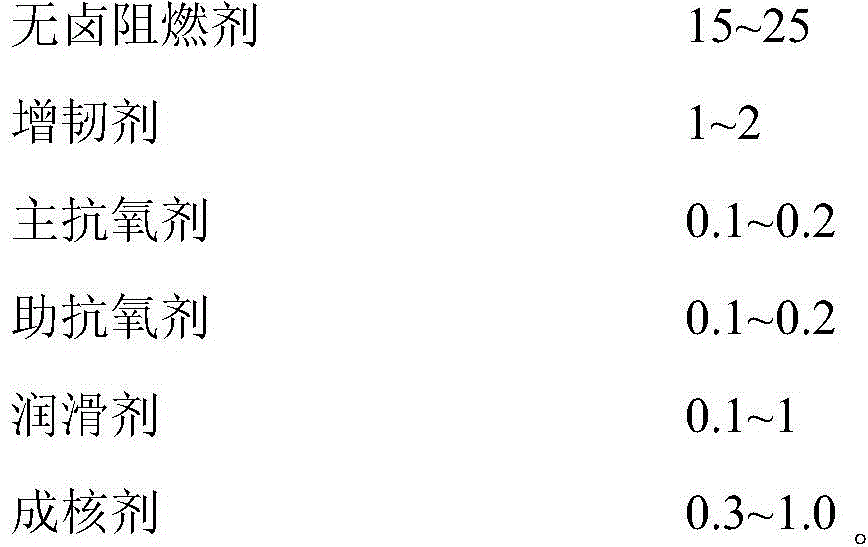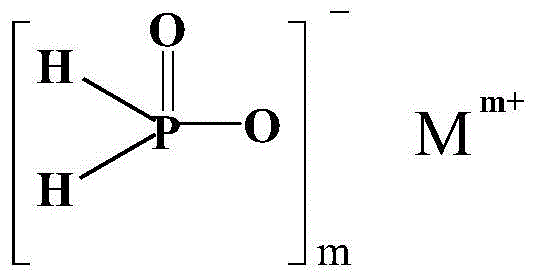A kind of halogen-free and phosphine-free Pbt reinforced composite material and preparation method thereof
A technology for reinforcing composite materials and raw materials, which is applied in the field of halogen-free and phosphine-free PBT reinforced composite materials and its preparation, which can solve the problems of metal corrosion, affecting the appearance and normal use of parts, and achieve excellent anti-tracking performance.
- Summary
- Abstract
- Description
- Claims
- Application Information
AI Technical Summary
Problems solved by technology
Method used
Image
Examples
Embodiment 1
[0040] ① Preheating: heat-treat PBT resin (1100-211M) at 125-130°C for 4 hours.
[0041] ② Weighing:
[0042] Weigh each component raw material by weight: PBT (1100-211M): 57.2, halogen-free flame retardant: 20, ethylene-butyl methacrylate-glycidyl acrylate copolymer: 1.5, hindered phenolic antioxidant 1010: 0.2, phosphite antioxidant 168: 0.1, calcium stearate: 0.5, nano magnesium hydroxide: 0.5.
[0043] Add 1,000 parts of water (the following are parts by weight), 220 parts of aluminum hypophosphite, and 130 parts of cyanuric acid to the reaction kettle in order, turn on steam heating, start stirring, and add 126 parts of melamine after the temperature of the system rises to 85-90°C . Maintain the system at a constant temperature of 95-105°C for reaction, and stop stirring after the reaction is complete. Cool down, settle, remove the supernatant, wash and dry to obtain the previous product. Add 21 parts of magnesium oxide to the previous product, and at the same time us...
Embodiment 2
[0047] ① Preheating: heat-treat PBT resin (1100-211M) at 120-125°C for 5 hours.
[0048] ② Weighing:
[0049] Weigh the raw materials of each component by weight: PBT (1100-211M): 49, halogen-free flame retardant: 18, glycidyl methacrylate grafted POE: 1.5, phenolic antioxidant 1010: 0.15, sub Phosphate antioxidant 168: 0.15, N,N-diethylbisstearamide: 0.5, nanometer calcium carbonate: 0.7.
[0050]Add 1,000 parts of water (the following are parts by weight), 220 parts of aluminum hypophosphite, and 130 parts of cyanuric acid to the reaction kettle in order, turn on steam heating, start stirring, and add 126 parts of melamine after the temperature of the system rises to 85-90°C . Maintain the system at a constant temperature of 95-105°C for reaction, and stop stirring after the reaction is complete. Cool down, settle, remove the supernatant, wash and dry to obtain the previous product. Add 21 parts of magnesium oxide to the previous product, and at the same time use 3.5 par...
PUM
| Property | Measurement | Unit |
|---|---|---|
| melting point | aaaaa | aaaaa |
| diameter | aaaaa | aaaaa |
| melt flow index | aaaaa | aaaaa |
Abstract
Description
Claims
Application Information
 Login to View More
Login to View More - R&D
- Intellectual Property
- Life Sciences
- Materials
- Tech Scout
- Unparalleled Data Quality
- Higher Quality Content
- 60% Fewer Hallucinations
Browse by: Latest US Patents, China's latest patents, Technical Efficacy Thesaurus, Application Domain, Technology Topic, Popular Technical Reports.
© 2025 PatSnap. All rights reserved.Legal|Privacy policy|Modern Slavery Act Transparency Statement|Sitemap|About US| Contact US: help@patsnap.com



